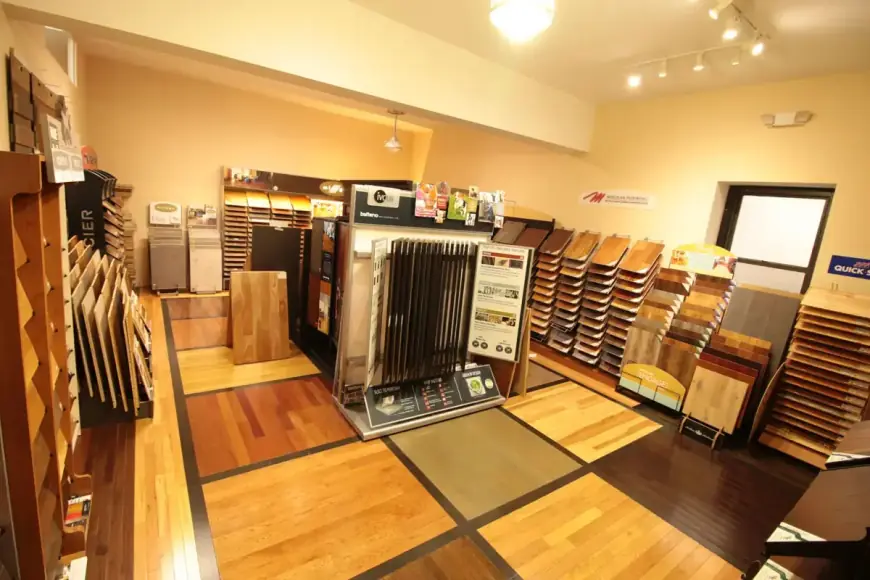Prefinished vs. Unfinished Hardwood Floors: What’s the Difference?
Learn the key differences between prefinished and unfinished hardwood floors—durability, installation time, finish options, and long-term maintenance impact.

When embarking on a new flooring project, the allure of real hardwood is undeniable for many American homeowners. Its timeless beauty, durability, and ability to add significant value to a home make it a perennial favorite. However, once you decide on hardwood, a fundamental question arises: Should you choose Prefinished Hardwood Flooring or Unfinished Hardwood Flooring?
While both options ultimately deliver the same beautiful natural wood, their journey from the mill to your home, their installation process, aesthetic possibilities, and long-term maintenance differ significantly. Understanding these distinctions is crucial to making an informed decision that aligns with your project timeline, budget, lifestyle, and design vision. This comprehensive guide will dissect the core differences between prefinished and unfinished hardwood flooring, helping you navigate this essential choice for your American home.
1. The Core Distinction: Where the Finish is Applied
The most fundamental difference lies in the timing and location of the wood's protective finish application.
Prefinished Hardwood Floors
-
Definition: These planks arrive at your home with the stain and multiple coats of protective finish (like aluminum oxide, urethane, or oil) already factory-applied and cured. They are ready for immediate installation and use upon delivery.
-
Process: The wood undergoes a highly controlled finishing process in a manufacturing facility. Each plank is machine-sanded, stained (if desired), and then typically receives numerous coats of finish, with each coat cured under UV lights for exceptional hardness and consistency.
-
Availability: Widely available in both solid and engineered formats.
Unfinished Hardwood Floors
-
Definition: These planks are delivered as raw, bare wood. The sanding, staining (if desired), and application of protective finish all occur after the flooring has been installed in your home.
-
Process: After installation, the entire floor is sanded smooth (often multiple times with different grits), cleaned, stained (if chosen), and then several coats of a protective finish are applied on-site. Each coat requires drying time, and the final cure can take days or weeks.
-
Availability: Typically solid hardwood, though some engineered wood is also sold unfinished.
Key Takeaway: Prefinished means the work is done before it arrives; unfinished means the work is done in your home.
2. Installation Process & Timeline
The "finish-off-site" vs. "finish-on-site" distinction profoundly impacts the installation timeline and on-site disruption.
Prefinished Hardwood
-
Installation Speed: Significantly faster. Once delivered and acclimated, the planks are installed, and the floor is immediately ready for furniture and foot traffic. There are no sanding, staining, or drying times.
-
On-Site Disruption: Minimal. No dust from sanding, no fumes from finishes, no need to vacate the premises for extended periods. This is a major advantage for homeowners living in the house during renovation or for projects with tight deadlines.
-
Cleanliness: Much cleaner, as all sanding and finishing by-products are contained within the factory.
Unfinished Hardwood
-
Installation Speed: Much longer. After the planks are installed, the floor needs to be sanded (multiple passes), stained (if desired), and then multiple coats of finish are applied, each requiring drying time. The entire process, from raw wood installation to ready-for-use, can take several days to over a week, depending on the number of coats, humidity, and chosen finish.
-
On-Site Disruption: Significant. The sanding process creates a large amount of fine wood dust (even with dust containment systems). The application of finishes involves fumes (which can be strong, especially with oil-based polyurethanes) requiring good ventilation and often necessitating homeowners and pets to vacate the property for days.
-
Cleanliness: Dusty and potentially messy, requiring thorough post-installation cleaning.
Key Takeaway: Prefinished offers speed and minimal disruption; unfinished hardwood flooring requires more time and creates more on-site mess.
3. Aesthetic & Customization Options
The choice impacts how much you can personalize the final look of your floor.
Prefinished Hardwood
-
Customization: Less flexible. You choose from a pre-determined range of wood species, stain colors, sheen levels, and surface textures (e.g., smooth, hand-scraped, wire-brushed). What you see is what you get.
-
Visual Consistency: Due to factory application, finishes are highly uniform across all planks. This means excellent consistency in color, sheen, and durability from plank to plank.
-
Edge Details: Often features micro-bevelled edges (a very small chamfer) to hide slight height differences between planks, which are more common in factory-finished products.
Unfinished Hardwood
-
Customization: Highly flexible. You have ultimate control over the final look.
-
Unlimited Stain Colors: Can be stained to any color imaginable on-site.
-
Custom Sheen Levels: Can achieve specific sheen levels.
-
Seamless Look: The entire floor is sanded perfectly flat after installation, creating a smooth, monolithic surface without micro-bevels, giving a traditional, seamless appearance.
-
Custom Effects: Can achieve custom distressing or unique finish effects.
-
Visual Consistency: Can be challenging to achieve perfect uniformity in stain and finish across a large area, as it's applied by hand. However, a skilled craftsman can produce stunning, bespoke results.
-
Edge Details: Can be installed and then sanded perfectly flat, resulting in a virtually seamless floor from edge to edge.
Key Takeaway: Unfinished offers unparalleled customization for a truly bespoke floor; prefinished offers consistent, factory-perfect finishes with less flexibility.
4. Durability & Finish Quality
The factory environment often allows for superior finish application.
Prefinished Hardwood
-
Finish Durability: Generally superior. Factory finishes are applied in controlled environments with multiple coats (often 7-10 or more) of highly durable materials like aluminum oxide, cured with UV light. This creates an incredibly hard, scratch-resistant, and consistent protective layer.
-
Consistency: Each plank receives the exact same number of coats and curing process, leading to uniform durability across the entire floor.
-
Warranty: Often comes with extended finish wear-through warranties (10-25 years or even lifetime for residential use), indicating manufacturer confidence in the finish's longevity.
Unfinished Hardwood
-
Finish Durability: Varies based on the skill of the installer/finisher, the quality of the finish products used, and on-site environmental conditions (dust, humidity). While excellent finishes can be applied, achieving factory-level hardness and consistency can be challenging.
-
Consistency: Dependent on manual application, which can lead to slight variations in sheen or thickness.
-
Warranty: Typically, warranties cover the wood itself, but the finish warranty depends on the product chosen and the applicator's guarantee.
Key Takeaway: Prefinished generally boasts a more durable and consistently applied finish due to factory control.
5. Cost Considerations
Initial material cost vs. total project cost.
Prefinished Hardwood
-
Material Cost: Often appears higher per square foot/meter for the material itself because it includes the finishing process.
-
Installation Cost: Lower total installation cost because there's no on-site sanding, staining, or finishing labor.
-
Hidden Costs: Minimal. You know the exact material cost upfront.
-
Overall Project Cost: Often results in a lower overall project cost and faster completion time.
Unfinished Hardwood
-
Material Cost: Typically lower per square foot/meter for the raw wood planks.
-
Installation Cost: Significantly higher total installation cost due to the extensive on-site labor for sanding, staining, and multiple coats of finish, plus the cost of those finishing materials.
-
Hidden Costs: Potential for unexpected costs if extra sanding is needed, or if environmental conditions cause issues during curing.
-
Overall Project Cost: Can be higher and less predictable due to variable labor and finishing material costs.
Key Takeaway: Prefinished often has a higher material price but a lower total installed cost; unfinished has a lower material price but a much higher total installed cost due to labor and finishing materials.
Conclusion: Making the Right Choice for Your American Home
The decision between prefinished and unfinished hardwood flooring ultimately hinges on your priorities.
-
Choose Prefinished if:
-
You prioritise speed of installation and minimal disruption.
-
You prefer a cleaner, less messy installation process.
-
You value a highly durable, factory-applied finish with a strong warranty.
-
You are comfortable choosing from a wide array of existing styles and finishes.
-
You want a more predictable overall project cost and timeline.
-
You live in the home during renovation.
-
Choose Unfinished if:
-
You desire ultimate customisation in stain color, sheen, and surface texture.
-
You want a truly seamless, traditional look without micro-bevels.
-
You are willing to accept a longer, more disruptive installation period with dust and fumes.
-
You have the budget for higher labor and finishing material costs.
-
You trust your installer/finisher to deliver a high-quality, custom finish on-site.
-
You want to match existing hardwood floors perfectly.
Both prefinished and unfinished hardwood floors will bring the natural beauty of wood into your home. By understanding their distinct differences in process, aesthetics, durability, and cost, you can confidently select the option that best serves your needs and ensures lasting satisfaction with your new floor. Visit Rustic Wood Floor Supply for your wholesale orders and supplies.
What's Your Reaction?
 Like
0
Like
0
 Dislike
0
Dislike
0
 Love
0
Love
0
 Funny
0
Funny
0
 Angry
0
Angry
0
 Sad
0
Sad
0
 Wow
0
Wow
0



















































